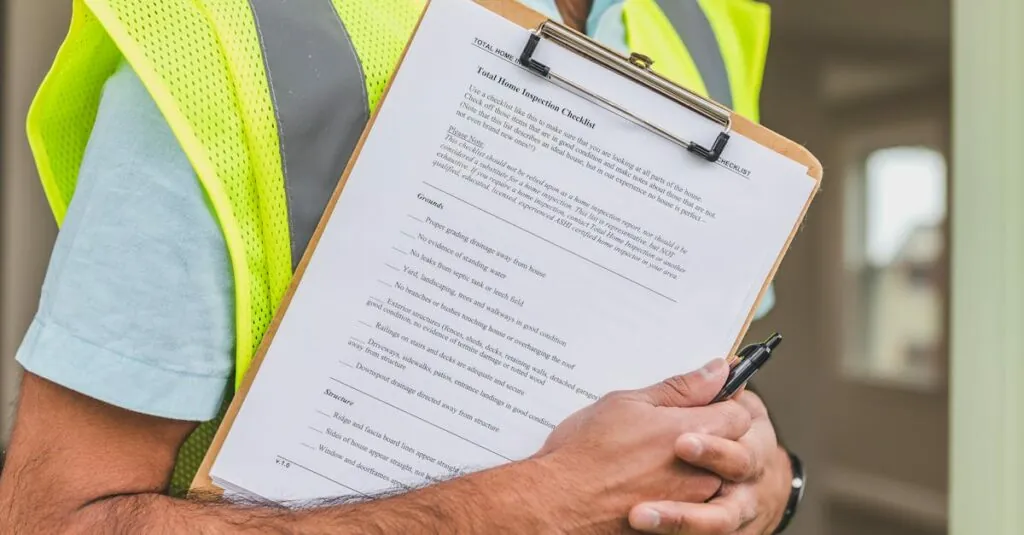Table of Contents
ToggleEvery homeowner knows that keeping a house in tip-top shape is no walk in the park. Between leaky faucets and squeaky doors, it can feel like a never-ending game of whack-a-mole. Enter the maintenance checklist template—a superhero in disguise, ready to save the day! With this handy tool, anyone can tackle home upkeep like a pro, avoiding costly repairs and unexpected surprises.
What Is a Maintenance Checklist Template?
A maintenance checklist template serves as a structured guide for homeowners to track their property upkeep. It outlines essential tasks necessary for maintaining various systems and components within a home. Such tasks may include inspecting roofs, servicing heating and cooling systems, and checking plumbing fixtures.
Utilizing a maintenance checklist template simplifies scheduling regular maintenance activities. It provides a clear overview of items that require attention, making it easier to identify potential issues before they escalate. This proactive approach enhances the longevity of home systems and reduces the likelihood of costly repairs.
Homeowners can customize these templates to fit specific property needs. Adjustable templates allow for the addition of seasonal tasks, like gutter cleaning in the fall or lawn care in the spring. By tailoring the checklist, individuals ensure comprehensive coverage of their home maintenance needs.
Incorporating a maintenance checklist helps track completed tasks. Individuals can mark off activities as they complete them, which fosters a sense of accomplishment. It also aids in identifying patterns of neglect, prompting timely intervention when necessary.
When maintained consistently, a checklist can highlight the frequency of specific tasks. For instance, checking smoke detectors every six months ensures they function properly, enhancing safety. Regular reviews of completed tasks provide valuable insight into long-term maintenance trends.
A well-prepared maintenance checklist template stands as a vital tool for any homeowner. It streamlines upkeep and aids in preventing unexpected repair costs, contributing to a well-maintained property. Properly utilizing this template offers peace of mind while promoting ideal living conditions.
Importance of a Maintenance Checklist
A maintenance checklist serves as a critical resource for homeowners. Keeping a structured guide ensures efficient property upkeep.
Benefits for Businesses
Businesses can significantly enhance operational efficiency with a maintenance checklist. It allows for organized tracking of maintenance tasks, minimizing equipment downtime. Staff members can quickly identify necessary repairs, leading to better resource allocation. Furthermore, a checklist aids in budgeting for maintenance activities, ensuring costs remain manageable. Teams appreciate the streamlined communication it fosters, as everyone stays informed about ongoing tasks. Consistently using a checklist promotes accountability among employees, improving overall workplace morale.
Impact on Safety and Compliance
Safety benefits arise directly from utilizing a maintenance checklist. Regular inspections of essential systems, such as fire alarms, optimize compliance with safety regulations. It assists in identifying potential hazards before they escalate into serious issues. Tracking maintenance activities ensures that safety protocols remain intact, reducing the risk of accidents and injuries. Additionally, documented checklists serve as evidence during audits, demonstrating commitment to safety standards. By prioritizing compliance, homeowners and businesses maintain safe environments for residents and employees alike.
Key Components of a Maintenance Checklist Template
A maintenance checklist template comprises various essential elements that enhance its effectiveness.
Essential Items to Include
Core items must feature prominently in any template. Start with the scheduling of inspections for crucial systems like plumbing, electrical, and HVAC components. Include tasks for seasonal maintenance, such as clearing gutters and checking smoke detectors. Record any repairs or replacements necessary, along with their completion dates. Documenting these tasks ensures that no critical aspects fall through the cracks. Additionally, checklists should incorporate safety inspections, especially for fire alarms and carbon monoxide detectors. These items provide a comprehensive framework for maintaining a safe and functional living environment.
Customization Options
Customization options significantly improve the utility of a maintenance checklist. Homeowners can modify templates to align with specific property features and personal preferences. For example, add seasonal tasks to accommodate local climate conditions. Include notes for unique appliances or systems requiring specialized care, which enables targeted attention. Furthermore, homeowners might prioritize urgent tasks, ensuring critical maintenance occurs promptly. Incorporating checkboxes or progress tracking can boost accountability, motivating individuals to stay on top of maintenance duties. Personalizing checklists fosters a commitment to regular upkeep, enhancing overall property management.
How to Create an Effective Maintenance Checklist Template
Creating an effective maintenance checklist template involves a systematic approach. Homeowners can start by identifying key areas of maintenance, including plumbing and electrical systems.
Step-by-Step Guide
- List essential tasks based on routine upkeep needs.
- Categorize tasks into daily, monthly, and seasonal maintenance.
- Include specific details, such as the location of systems and parts that require inspection.
- Design a user-friendly layout with clear sections for ease of use.
- Utilize checkboxes to track progress easily.
Update the checklist regularly to reflect any changes in maintenance schedules or property status.
Tools and Resources
Homeowners can benefit from various tools and resources to enhance their checklist creation.
- Digital templates are widely available online for free and premium options.
- Mobile apps can streamline task management and send reminders.
- Software like spreadsheets allows for customization and detailed tracking.
- Local hardware stores often provide printed guidelines for specific maintenance tasks.
Utilizing these tools helps ensure a comprehensive approach to property maintenance.
Best Practices for Using a Maintenance Checklist Template
Customize the template to meet specific property needs by adding seasonal tasks. Identify critical areas of maintenance, such as plumbing or HVAC, to focus on high-priority items. Utilize digital tools for creating checklists, which can enhance organization and accessibility. Track completed tasks to instill a sense of accomplishment and highlight neglected areas.
Revisit the checklist regularly, ensuring all tasks remain relevant and timely. Engage team members in the process to enhance accountability, especially in a business setting. Prioritize tasks based on urgency, frequency, and safety impact for better resource allocation. Review completed tasks periodically to understand maintenance trends and adjust future actions as necessary.
Incorporate checkboxes to provide a visual cue for task completion. Encourage regular inspections of essential systems, like fire alarms, to ensure compliance with safety standards. Utilize checklists during audits as documented evidence of adherence to established protocols. Communicate effectively with staff by sharing the checklist, promoting a collaborative maintenance culture.
Integrate reminders for upcoming maintenance activities to prevent oversight. Focus on a user-friendly layout to simplify navigation and ensure clear task visibility. Leverage community resources or professional services for additional knowledge and support. Aim for consistency by using the checklist daily, monthly, or seasonally, depending on the task’s urgency.
Conclusion
Utilizing a maintenance checklist template can transform how homeowners manage their property upkeep. It not only simplifies the organization of maintenance tasks but also empowers homeowners to stay proactive in addressing potential issues. By customizing the checklist to fit specific needs and incorporating regular reviews, they can enhance the longevity of their home systems.
This approach not only fosters a sense of accomplishment but also contributes to a safer living environment. For businesses, the benefits extend to improved operational efficiency and compliance with safety regulations. Ultimately, a well-structured maintenance checklist template is an indispensable resource that supports effective management and promotes peace of mind.







